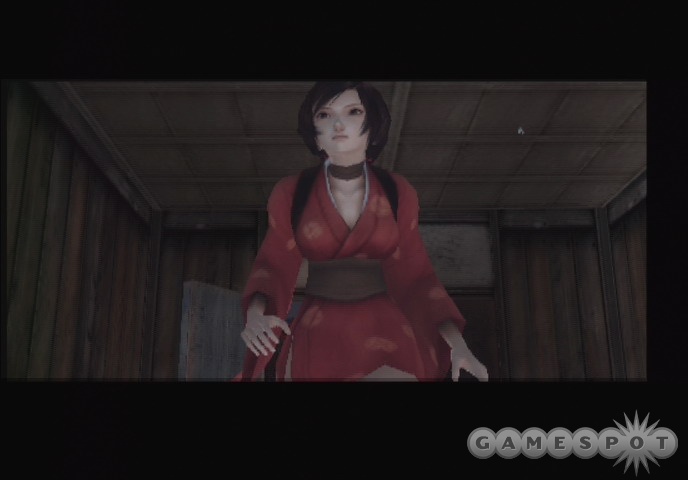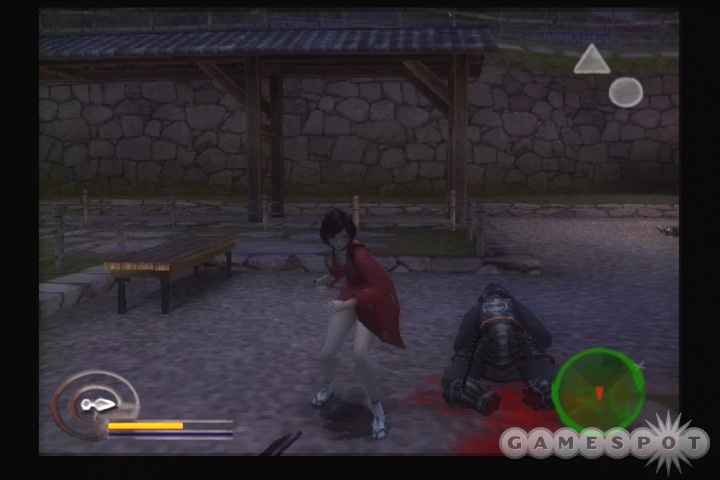With quality games like Ninja Gaiden (and to a slightly lesser degree, the entries in the Tenchu series) currently available on the market, the ever-popular ninja action genre is an increasingly crowded place. As the crowd grows, new ninja games are trying to find different ways to stand out. But apart from the fact that the game's heroine is a buxom, scantily robed assassin, there's really nothing at all to Red Ninja that stands out in any meaningful way. From its barely existent storyline, to its laborious and periodically broken platforming mechanics, to its sadly underdeveloped combat, Red Ninja just never manages to pull itself from action game mediocrity.

The aforementioned buxom heroine of Red Ninja is Kurenai, who, at the beginning of the game, is the young daughter of a prominent Japanese engineer during the "warring states" period of Japanese history. The clans of Shingen Takeda and Nobunaga Oda are in the thick of a major war, and when an evil ninja clan attacks Kurenai's father's workshop (seemingly for the purpose of stealing the plans for a terrible weapon he had been working on), Kurenai's father is killed, and Kurenai is left hanging from a tree by a tetsugen, a bladed wire used by ninjas. Kurenai is subsequently rescued by a kindly woman from the Takeda clan and then is trained in the deadly assassin ways of the ninja. From here on out, it's a twisting, turning, barely coherent romp on Kurenai's quest for revenge against the ninjas who killed her father. The game will present you with cutscenes from time to time that introduce random new characters, as well as set up missions, but there's nothing very engaging about any of them. You can easily fault the writers of the game, or the dullard actors portraying the characters, or the designers who failed to give them any unique characteristics. In fact, just fault them all at once, because there's plenty of blame to spread around.
Most of Red Ninja's gameplay consists of you, as Kurenai, running around a level, jumping, swinging, and running up walls, while occasionally cutting up brain-dead enemies and fighting periodic bosses. The primary combat mechanic you'll encounter involves the tetsugen, the very weapon that Kurenai was once strung up by. As a basic weapon, you can use the tetsugen to latch onto enemies from a short distance away. By pulling the weapon back, you'll do a fair amount of damage. One or two more hits after that should leave the enemy with a severed head or torso, depending on where you targeted him. As you play, you'll earn new blade types and attacks that you can use with the weapon. The tetsugen is a neat idea, but the one problem that persists with it is that it makes combat ridiculously easy. As you are a ninja, your primary goal, most of the time, is to sneak up on enemies and kill them quickly. Even if you somehow botch this, you can usually just throw a couple of quick hits with the tetsugen to kill the poor half-wit in front of you before he can properly call for help.
You'll find yourself with other weapons in Red Ninja, like a blowgun that stuns (and occasionally kills) enemies from a distance; throwing knives that aren't very accurate but are effective when they land; and a basic dagger that Kurenai can use when up close and personal with an enemy. However, you probably won't even really need any of these weapons, save for some very specific missions that call for them. The tetsugen is such an effective weapon that it renders much of the combat a simplistic bore. Of course, it doesn't help that nearly every enemy is a total idiot and is thoroughly easy to dispatch in a moment's notice, thanks to a few contextual attacks that make everything even easier. If you run up behind an enemy and hit the attack button at the right time, you'll one-hit kill the guy instantly. And unlike other ninja-themed games that have offered similar mechanics, here in Red Ninja, this is very easy to do.
Another tactic you can employ is something of a "seduce" mechanic, where, if you're flattened against a wall and are peering around a corner, you can press a button to basically make Kurenai do something vaguely sexy to try to lure a guard to his doom. Sometimes the guard doesn't buy into it and will come charging at you, spear blazing, but quite often--and in grand cliché fashion--the guard will take the leap of logic that leads a nameless grunt enemy to throw his duties by the wayside to go running to his doom just because a pretty woman he's never ever seen before proffers herself to him. Right. While we'd certainly believe a few members of Nobunaga Oda's massive army were capable of letting their libidos get in the way of their judgment, the frequency with which this works in Red Ninja makes you wonder why the leaders of ancient Japanese armies just didn't employ whole armies of large-breasted female ninjas with come-hither looks in their eyes.
Of course, Red Ninja wouldn't be a true ninja action game if it didn't at least flirt with the notion of some high-flying platforming action, and it certainly does more than entertain the idea. All the game's various levels are littered with poles to swing from, walls to run up and down, and ledges to jump to and from. Some actions, like ledge climbing and wall running, are done entirely through contextual action, meaning you won't even really have to press any buttons, because the game will do it for you, provided you hit the ledge or wall at the right angle. This might work in theory, were the mechanics not so utterly random. With wall running, for instance, it seems like no two walls are ever alike in terms of how far you'll be able to run along them. Sometimes you'll be able to get a good run across, while sometimes you won't. And sometimes the wall will somehow randomly push you off for no good reason at all. This isn't even limited to different walls, either. Sometimes you'll take a few tries on the same wall, and it will never work quite the same way multiple times. It's near-on impossible to get a real feel for these context-sensitive actions, thus leading to endless bouts of trial and error that become intensely frustrating very quickly.
The most maddening thing about the platforming aspect of the game, however, is the camera. The camera used in Red Ninja is nothing short of completely broken, totally obliterating any shot you might have of orienting yourself and seeing any of what you really need to see to perform the assorted jumps and swings you need to perform to advance. The main catalyst that causes the camera to break seems innocent enough, at first. Basically, the camera will always try to snap back behind Kurenai any time you move her. While this is obviously intended to be helpful, it ends up turning the game into a confusing, spastic mess. This is especially bad when you're in a tight space or maze where you have to turn around a lot, because you're guaranteed to become horribly disoriented within seconds. And as for any sections with a lot of platform-jumping? Might as well forget about it. You can do it, but not without a lot of frustrating trial and error and not without a lot of fluky misses that completely result from the camera refusing to settle down to let you pick out a proper angle. To be fair, you can get used to some of the camera nonsense, but there will always be times when you'll just blatantly miss jumps or mistime wall runs because the camera didn't feel like being your friend.
Outside of the horrendous camera, Red Ninja actually isn't a half bad-looking game. The graphical engine the game employs is technically sound, and everything moves at a pretty brisk clip, with no slowdown or similar issues on either the Xbox or PlayStation 2 versions. The Xbox version also makes good use of light bloom effects to give everything kind of a soft-lit look. And both versions feature hefty amounts of blood that spurt every which way from recently eviscerated foes. However, while the graphics are technically good, aesthetically, there's really not much to the game's visuals. All the assorted levels, characters, and what have you are all detailed, but there's nothing unique about any of them. Kurenai is about as blank of a heroine as we've ever seen, with no personality whatsoever. And pretty much all the other side characters seem like blatant rip-offs of characters from other ninja games. All the environments, while technically different, just seem to kind of have the same bland look across the board. Other similar games have managed to do creative and interesting things with the whole ancient Japan motif, but Red Ninja never really seems to have any creative aspirations at all.

The audio is mostly decent, but it has a few rough spots. Mainly, the voice acting is the primary issue with the game's sound presentation, as it varies wildly in quality. Kurenai is mainly just boring, but the remaining characters are all either wickedly over-the-top, to the point of ludicrousness, or just severely annoying. You'll find some decent sound effects while you play, though nothing remarkable, and the traditional flute music that makes up much of the soundtrack is mostly pleasant, though it's a tad repetitive.
Red Ninja: End of Honor ultimately fails to achieve what even the most boilerplate of ninja action games have managed to achieve in recent years. It simply takes all the most obnoxious mechanical failings of the games that have preceded it and packages them with characters and a story that are extremely difficult to get attached to. Even for those diehard ninja fans out there, Red Ninja is probably not a game that's worth your time or money.